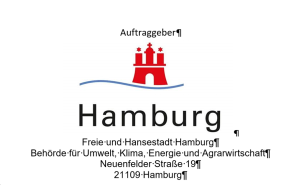Arsenic immobilization by iron sulfide precipitates
|
Project team: Martin Maier, Charlotte Stirn |
Financenced by: Hamburg Environmental Authorities (Behörde für Umwelt, Klima, Energie und Agrarwirtschaft, BUKEA)
|
Background/Summary
At a former industrial site, arsenic was released at very high concentrations into the groundwater. The volume of contaminated aquifer was estimated to be 5 Mio m3. According to our investigations of the sediment and the groundwater, the Arsenic is only weakly bound to the sediment surfaces and therefore very mobile. According to a Master thesis (Müller, 2020) electrocoagulation is suitable to treat highly arsenic contaminated water fractions in reasonable treatment time and with relatively small sludge generation.
Additionally, for the immobilization of Arsenic we investigated the general suitability of adding ferrous sulphate (oxic) and lactate as a carbon source to sediment and groundwater filled bottles (batch test), in order to create anoxic conditions. The aim was to stimulate the precipitation of arsenic onto the sediment - ideally as a stable mineral form like iron sulfide. In a subsequent long-term experiment, the sediments from the most promising approaches were suspended in water-permeable bags in a heavily contaminated groundwater monitoring well at the site and left there for several months. In particular, two differently prepared approaches (oxic and anoxic) were compared with an untreated reference: Both approaches were suitable for completely removing the arsenic from the solution in the batch test. As expected, in the oxic test the arsenic adsorbed on the sediment sample dissolved again after a relatively short time (6-9 months) in the long-term test under the anoxic conditions. This is mainly due to the very weak binding forms of the arsenic to the sediment. In the anoxic test, the arsenic from the well accumulated in the sediment inside the water-permeable bag. The binding of the arsenic in the anoxic test turned out to be very strong, i.e. only soluble in the aqua regia digestion, but not in the other elution steps including hydrochloric acid elution. At the end of the experiment after 12 months, the arsenic content of the sediment remained at this enriched high level. The binding forms changed insignificantly, but a gradual shift towards more soluble forms became apparent.
Under the scanning electron microscope (SEM), crusts on the sediment with a composition of iron and sulphate could be detected in the long-term test of the anoxic batch. The hoped-for iron sulfide framboids with embedded arsenic as new phase formations, which had been found in preliminary tests in the sediment of the further outflow, could not be detected. It is possible that the sulfides formed were very small. Further research is ongoing, focusing on the additional addition of phosphorous fertilizer in order to increase crystalline growth.



